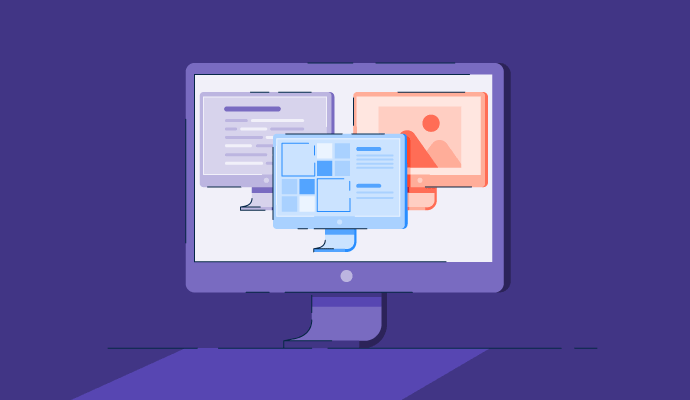February 16, 2024
 by Harshita Tewari / February 16, 2024
by Harshita Tewari / February 16, 2024

In the ever-evolving computing landscape, virtualization is the technology that transforms hardware resource utilization.
At the heart of this groundbreaking technology lies virtual machines (VM) tools meant to create and manage multiple isolated computing environments within a single physical host.
Virtual machines come in all shapes and sizes. A VM could be a virtual desktop infrastructure or a fully functional server. Virtualized applications, servers, and other machines provide scalable, versatile functionality for users.
You can experiment with virtual machines to try out a new operating system, make a virtual disk image of your hard drive, or go even further to construct an entire database server in the cloud.
Luckily, many server virtualization tools are free or open source, so you save money when you’re building a computer for your computer.
The following tools are ranked alphabetically:
Choosing the right OS can significantly impact your virtual machine's performance. Check out our list of the best operating systems and make an informed choice.
When we say system virtualization technology, we’re referring to fully virtualized machines capable of executing entire operating systems. These formidable products are stationed in G2’s server virtualization software category.
We also have a category for infrastructure as a service (IaaS) providers offering businesses cloud-based computing resources. If you are looking for tools to host and manage virtual desktops with remote accessibility, check out virtual desktop infrastructure (VDI) software. There's also remote access software or remote desktop software that lets you control a computer or virtual desktop via the internet.
The list below contains real user reviews for virtual machine software. Note that for this list, vendors offering a free trial are also considered.
To be included in this category, a solution must:
*This data was pulled from G2 in February 2024, and the product list is ranked alphabetically. Some reviews may have been edited for clarity.
Category: Infrastructure as a Service (IaaS) Providers
Azure Virtual Machines set users up to deploy and run powerful virtual computers in the cloud. A few different versions of the product are available as VM series for specific workloads and operating systems. Additionally, Azure VMs deliver sensitive data encryption, scalability, and versatile storage options.
The platform offers a free trial.
“Azure is an entire cloud-computing universe! A comprehensive and intuitive set of virtual tools for cloud and hybrid computing with endless options to configure platform as a service (PaaS), IaaS, and software as a service (SaaS) solutions.”
- Azure Virtual Machines Review, Jimmy H.
“Some of the services and data warehouse solutions in Microsoft Azure Cloud are confusing. It makes it hard to decide on the optimal service, tool, or cloud application suitable for the project.”
- Azure Virtual Machines Review, Ramy S.
Category: Server Virtualization Software
Citrix Hypervisor is a virtualization management platform that promotes the creation and management of VMs. The software is compatible with different operating systems and can handle all types of workloads. It also supplies robust storage options, a security system, cloud optimization, and enhanced 3D graphics support for smooth operations.
The software offers a free and licensed version.
“Citrix has an easy-to-manage interface which is quite administrator friendly. It offers single root I/O virtualization (SR-IOV) capabilities that enable low bandwidth network connection for VMs. It also offers dedicated features of Citrix Virtual apps and desktops that boost the performance of VDI tremendously.”
- Citrix Hypervisor Review, Saqib M.
“The software needs an upgrade. Sometimes it's slow and takes more time than expected to complete a task.”
- Citrix Hypervisor Review, Emaduddin A.
Category: Server Virtualization Software
Google Compute Engine is a fundamental part of Google Cloud Platform, providing Infrastructure as a Service (IaaS) capabilities. It leverages Google's extensive global infrastructure, which powers services like search, Gmail, and YouTube. With Google Compute Engine, users can easily launch virtual machines on demand, offering flexibility and scalability for various computing needs.
"Google Compute Engine makes it easy to manage CPU allocation and customize virtual machines through the cloud console. Their customer support is prompt, and you can integrate it smoothly with various technologies like Terraform and Kubernetes for your needs."
- Google Compute Engine Review, Abhiraj B.
"Managing resources, especially in large-scale deployments, can be complex despite the flexibility of the pay-as-you-go model. It's crucial for users to monitor resource usage closely to prevent unexpected costs from accumulating. Additionally, some users have experienced challenges with the responsiveness of Google Cloud Platform's customer support."
- Google Compute Engine Review, Aakriti M.
Category: Server Virtualization Software
Oracle VM is an open-source version of the Xen hypervisor for use on Windows, Linux, and Solar. It was originally released in 2012 but has received periodic feature updates to add functionality, including modern (domain zero) DOM0 kernel usage, increased virtual CPU configuration, and fiber channel storage.
The hypervisor can perform tasks like symmetric multiprocessing guest OSs, running arbitrary operating systems, and supporting guest OS drivers. Other capabilities include secure live virtual machine migration, virtual machine templates, and support for virtual appliances.
Oracle VM offers free download.
“What I like best about Oracle VM is that it provides a simple and user-friendly environment when using multiple operating systems on a single PC. It prevents data loss and correction while using two different operating systems. It helps so many people who are willing to work with different platforms at a time.”
- Oracle VM Review, Naresh R.
“We can't drag and drop a file from our host system to the virtual machine. This makes it very difficult to accomplish many of my tasks. Initial setup is a lengthy process and consumes a lot of time.”
- Oracle VM Review, Akhil K.
Category: Server Virtualization Software
Proxmox VE supports a wide variety of guest operating systems. The platform was created in response to OpenVZ’s failure to provide backup and management capabilities. Proxmox VE includes the virtualization environment, a web-based management console, and command-line tools. Proxmox also makes a representational state transfer (REST) API available for those who want to use third-party tools and pre-packaged server software appliances.
The platform provides free download and paid subscription models.
“Setting up and configuring networking in Proxmox VE can be complex. Also, support incurs additional costs.”
- Proxmox VE Review, Ramiro L.
“It's based on Linux, so sometimes things are harder, or you need some terminal skills. Also, you don't have access to a graphical interface at the console, so you have to connect via the web.”
- Proxmox VE Review, Pablo José R.
Category: Remote Desktop Software
QEMU is available on macOS, Windows, and Linux. It gives its users a way to mimic hardware, run guest operating systems, and develop virtual environments. QEMU is interoperable with KVM, which elevates it to near-native operating performance.
The software is free to download.
“QEMU runs on so many architectures and platforms, and it can be configured to run with minimal resources. This makes it perfect for embedding in hardware appliances with constrained resources.”
- QEMU Review, Lucas R.
“Documentation for getting started with QEMU can sometimes be a bit hard to move around. It's not because there is some problem with it; it's mainly because of the rich feature set and tons of options. Finding the ones that you care about can be tricky sometimes.”
- QEMU Review, Rajnesh K.
Category: Server Virtualization Software
Scale Computing Platform is a comprehensive infrastructure solution that integrates virtualization, server management, storage, and backup/disaster recovery capabilities into a single package. With robust fleet management features, it streamlines operations across edge-to-core environments. This unified approach not only enhances efficiency but also delivers substantial cost and time savings for organizations.
"The platform is straightforward to set up and deploy. Once it's up and running, spinning up new VMs and setting up backup scheduling is a breeze. I appreciate that you can purchase a cost-effective and comprehensive snapshot system while keeping your other systems dedicated to VMs. In the six years of utilizing Scale, I've only needed to contact support four times. Each interaction has been both friendly and professional, which is one of the main advantages of using the Scale system."
- Scale Computing Platform Review, Cliff W.
“I would appreciate having the option to continue receiving software support for "outdated" or end-of-life products. I can source replacement hard drives in case of failure, so having an extended software support option would be beneficial. This would allow me to extend the life of products for use as disaster recovery failover or archive servers."
- Scale Computing Platform Review, Josh C.
Category: Virtual Desktop Infrastructure (VDI) Software
VirtualBox is a versatile open-source virtualization software for enterprises and individuals. It runs on hosts such as macOS, Windows, Linux, and Solaris, while supporting a range of guest operating systems. Some capabilities are data synchronization, remote monitoring, and flexible networking support.
The software is available for free download.
“It is free to try with all updates also free. Pretty reliable and stable and won't let you down. Straightforward to use and fuss-free as compared to VMware. Nice support forums. File transfer, disk sharing, and snapshot options are easy to use.”
- VirtualBox Review, Harsimran S.
“The appearance and user interface of VirtualBox is not that appealing when compared to its alternates like VMware.”
- VirtualBox Review, Dhairya G.
Category: Server Virtualization Software
VMware ESXi is a type-1 hypervisor, which is a part of the VMware vSphere suite. It can run multiple virtual machines on a single physical server while delivering a user-friendly experience. ESXi offers enhanced security, IT footprint reduction, and configuration of VMs up to 6TB of random access memory (RAM), and 128 virtual CPUs.
The platform offers free download.
“VMware ESXi does what it is built for. I cannot think how virtualization would be possible without VMware ESXi servers and software. I like the ease of use and the ability to customize the most.”
- VMware ESXi Review, Sachin V.
“It’s a bit pricey if you have a small operation. It would be nice if you could just lease the specialized options like Storage Vmotion for the few times you actually need it.”
- VMware ESXi Review, Wayne R.
Category: Server Virtualization Software
VMware Fusion is another of VMware’s virtualization software specifically designed for macOS. You can run multiple operating systems as virtual machines on Mac without rebooting or changing the primary OS. Features include enhanced 3D graphics support and integration with other VMware products.
VMware Fusion is available for free download.
“The fact that VMware allows one to install multiple operating systems makes it a worthwhile application. To top it off, it is a cross-platform application. I can use it on MAC, Windows, and even Linux.”
- VMware Fusion Review, Christian I.
“The only thing I found to be a bit trickier to set up in VMware Fusion is the CPU/RAM/solid state drive (SSD) settings. Parallels had some handy templates when setting up a VM for the first time. VMware was missing that, which wasn't ideal, but I could still do it (just a learning curve, and they may have fixed this by now).”
- VMware Fusion Review, Adam M.
Category: Server Virtualization Software
VMware vSphere is a bare-metal hypervisor used for server virtualization. It comes with a built-in management tool, storage resource monitor, and hardened drivers for improved reliability. The hypervisor can support unlimited cores per CPU and unlimited CPUs per host. It can produce a maximum of eight virtual CPUs per virtual machine.
The hypervisor is available for free download.
“The best thing that I like about the VMware vSphere hypervisor is its speed. We can deploy virtual servers/desktops in minutes, and thus we can use the CPU and memory of the server efficiently. It's a type-1 hypervisor which virtualizes the servers into VMs. On top of the virtualized VMs, we can provision applications and desktops virtually.”
- VMware vSphere Review, Charan N.
“I do find that the learning curve is intense and that they could work on the knowledge base. You kind of have to be a specialist to manage this environment, which is less than ideal.”
- VMware vSphere Review, Scott H.
Virtual machine software is truly revolutionary. It not only gives you unmatched flexibility but also resource optimization and enhanced security. As a next step in selecting the right virtual machine software for your organization, make sure you involve teams from IT, DevOps, and security staff in the discussion.
Check for the software’s compatibility with your existing infrastructure and operating systems, and see that it fulfills all your needs. In no time, you’ll be able to unlock new possibilities in your computing landscape.
You have virtual machines up and running at work. The next thing you need is backup software to ensure that you have a system to protect your data and configurations within those VMs.
Harshita is a Content Marketing Specialist at G2. She holds a Master’s degree in Biotechnology and has worked in the sales and marketing sector for food tech and travel startups. Currently, she specializes in writing content for the ERP persona, covering topics like energy management, IP management, process ERP, and vendor management. In her free time, she can be found snuggled up with her pets, writing poetry, or in the middle of a Netflix binge.
Nowadays, it’s rare for an organization to not provide a way for people within it to access...
 by Mary Clare Novak
by Mary Clare Novak
High-performing teams don’t leave due diligence to chance.
.png) by Devyani Mehta
by Devyani Mehta
Is managing a geographically dispersed team slowing you down?
 by Mara Calvello
by Mara Calvello
Nowadays, it’s rare for an organization to not provide a way for people within it to access...
 by Mary Clare Novak
by Mary Clare Novak
High-performing teams don’t leave due diligence to chance.
.png) by Devyani Mehta
by Devyani Mehta


